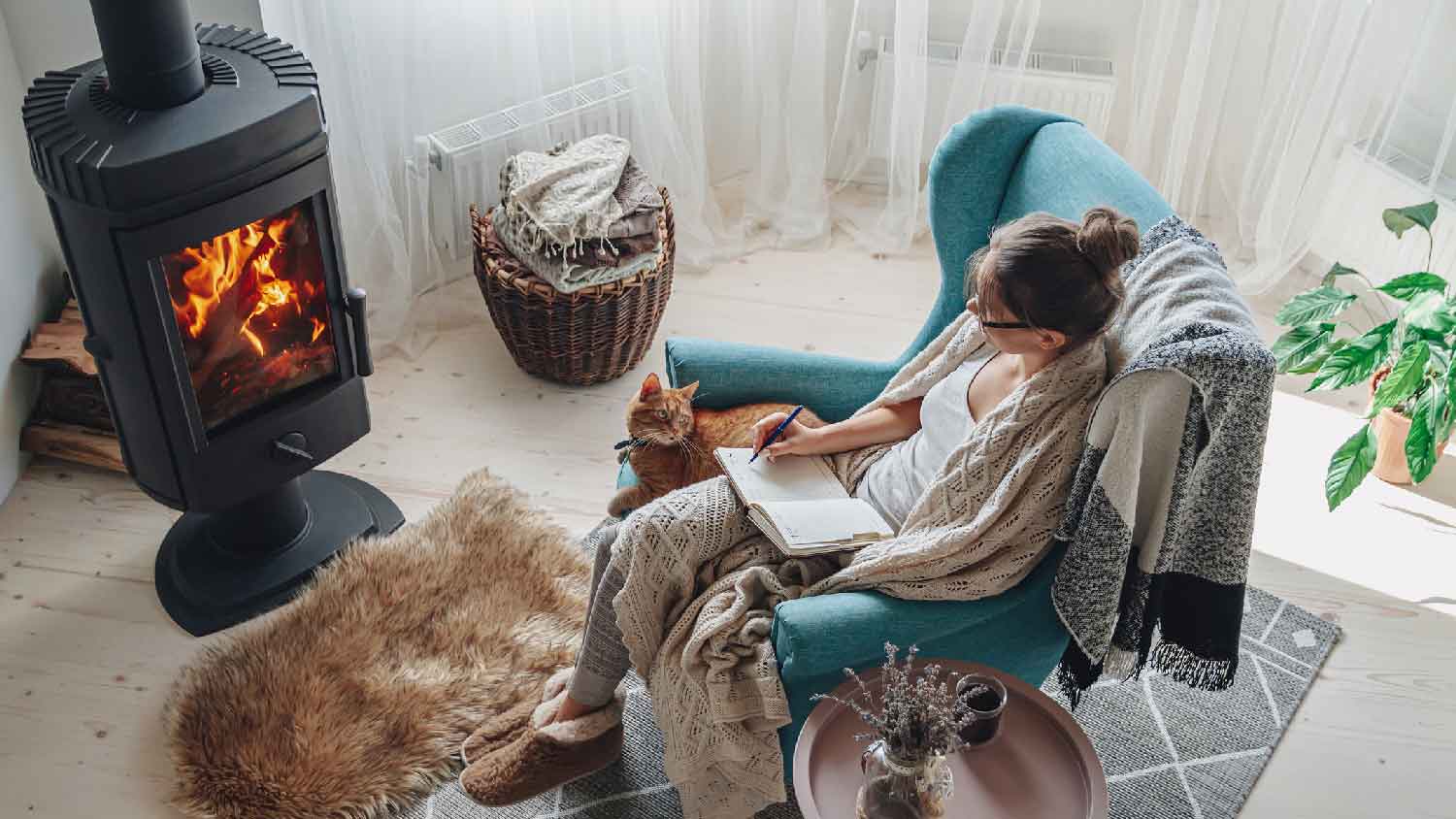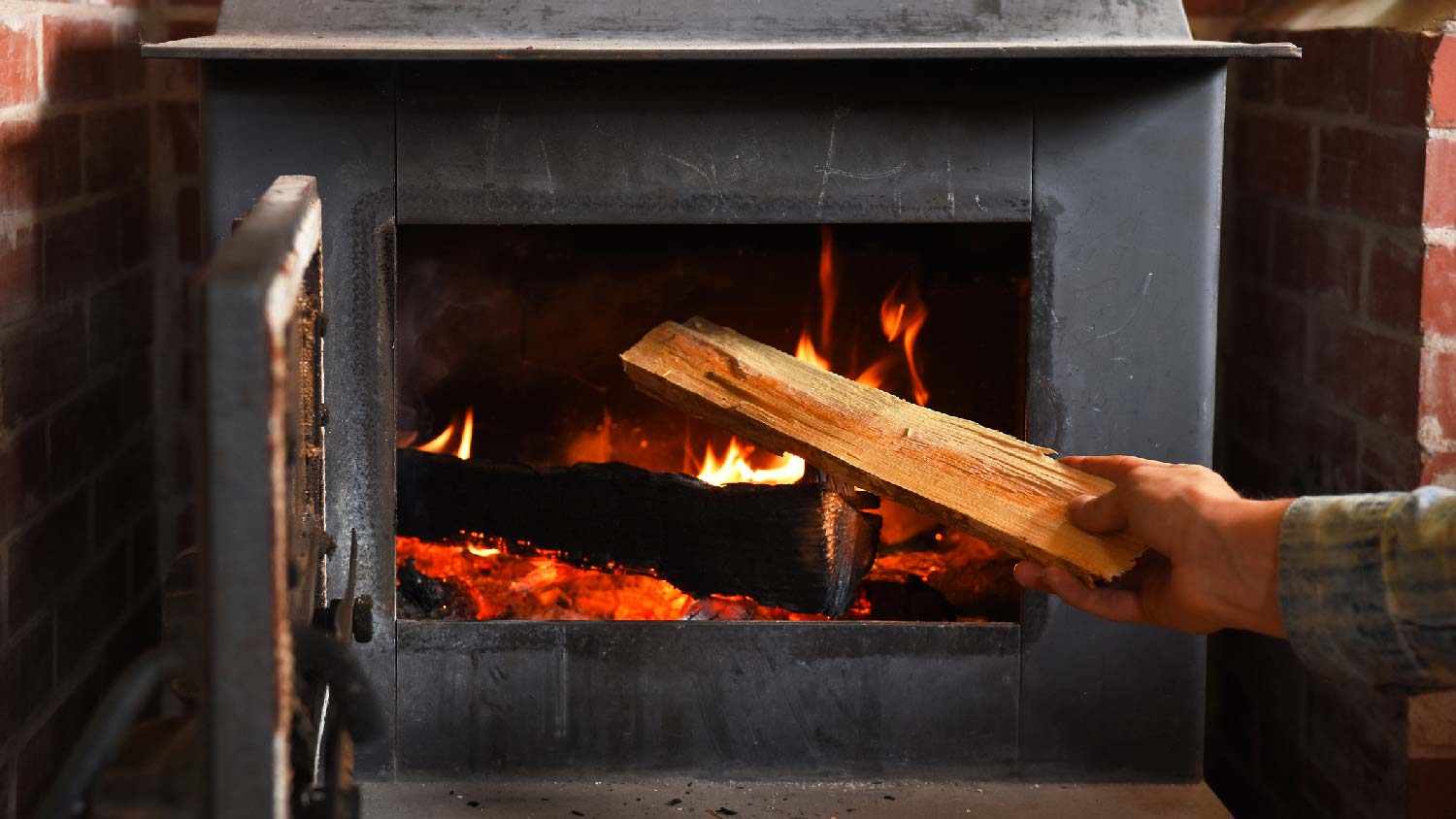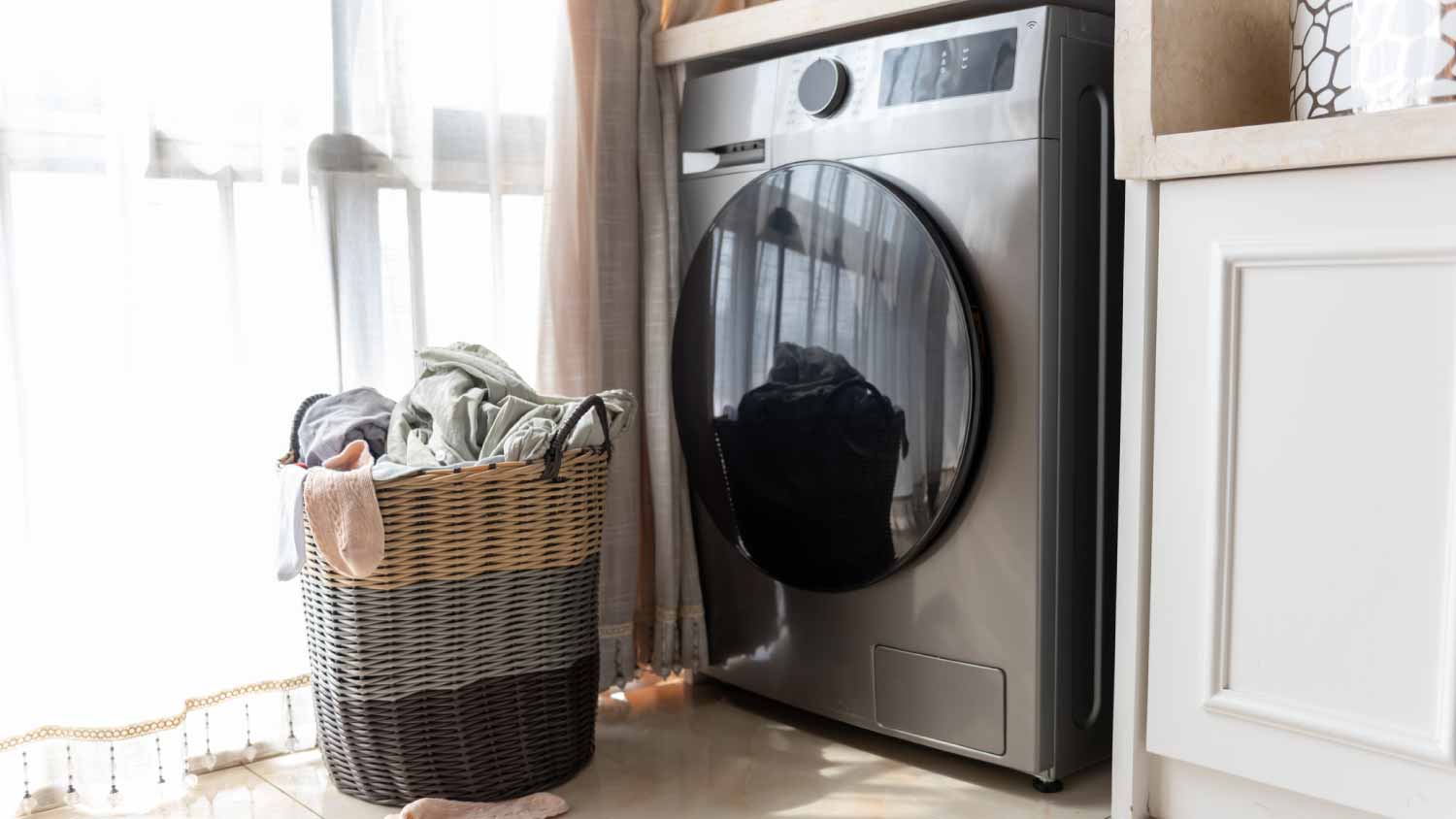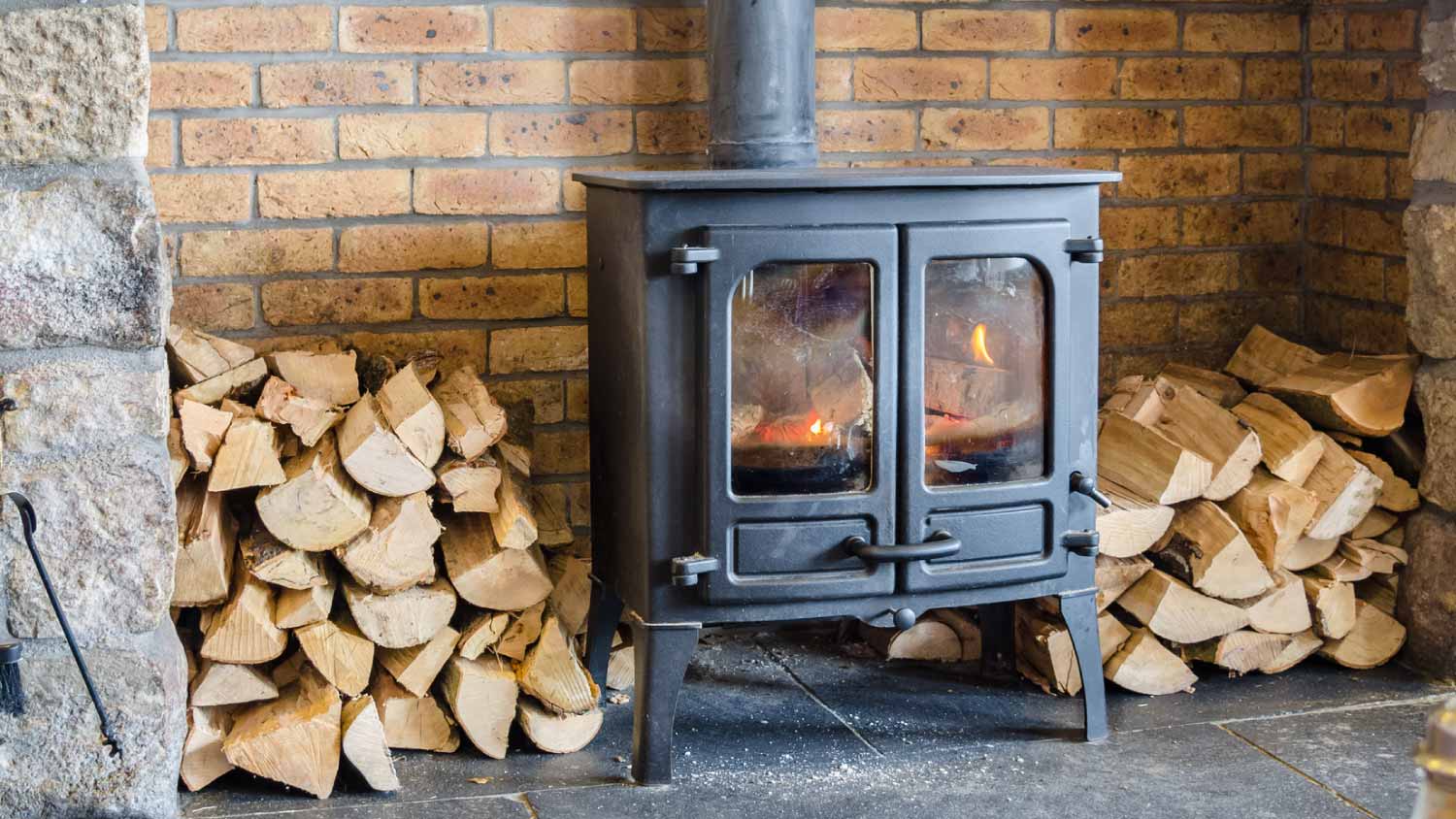What’s the Difference Between Cast Iron and Steel Wood Stoves?
Let’s light up the pros and cons of each heating option


Steel heats up quickly, but it doesn’t hold heat as long as cast iron.
Cast iron is a heavy material, so cast iron stoves can weigh 400 to 600 pounds.
Cast iron can last several decades, or even a lifetime, with proper care.
Wood-burning stoves cost $1,500 to $5,000, and steel costs less than cast iron.
Picture this: You come inside from shoveling snow off the sidewalk, and all you want to do is curl up by a warm fire with a cup of hot tea. A wood-burning stove could be just the addition to your living space to provide more efficient heating than a fireplace while also doubling as a decorative element. But these stoves come in two common materials: cast iron and steel. Consider a few major differences when deciding on whether a cast iron versus steel wood stove is right for your home.
Cast Iron vs. Steel Wood Stove: Key Differences
The major differences between a cast iron versus a steel wood stove are how fast the materials heat up, how long they retain heat, and how the stoves look. Cast iron is a thicker material, so it takes longer to heat. But once it’s warm, cast iron can retain the heat for far longer than a steel wood-burning stove. Another big difference is design. Cast iron can be poured into a variety of molds for more ornate and traditional looks, while steel comes in more sleek, modern designs.
What Is a Cast Iron Wood Stove?

Cast iron stoves have a long history, with the first manufactured cast iron stove dating back to 1642. A cast iron wood stove is made from an iron alloy, often containing carbon and silicon, that manufacturers pour into a cast to form intricate designs. Cast iron forms a thick, sturdy material that holds up well to flames. Because the material is so dense, it can provide radiant heating for a long time, even after the flames have gone out.
| Pros | Cons |
|---|---|
| Retains heat longer | Takes longer to heat |
| Ornate, traditional designs | Prone to cracking |
| Long life span | Heavy |
Best for:
Long-lasting heat
More traditionally decorated spaces
Homeowners wanting a stove with a long life span
Pros of Cast Iron Wood Stoves
If you want to ignite your wood stove once and enjoy heat for several hours, a cast iron stove is your best bet. This material has great heat retention properties, so it will keep heating your space with radiant heat even after the fire dwindles.
Cast iron offers more design options because it can be poured into casts for intricate and unique designs. For interior design enthusiasts, this can be an attractive benefit of cast iron stoves.
This material holds up well to cycles of heating and cooling. So, as long as you maintain it properly, a cast iron stove could last you several decades or even a lifetime.
Cons of Cast Iron Wood Stoves
One of the big drawbacks of cast iron is that it takes longer to heat up than steel, which isn’t ideal when you’re cold. If you choose a cast iron stove, you may want to consider adding a fan since wood stove fans work to distribute the heat as quickly as possible.
While wood stove installation is always best left to local wood stove pros, cast iron is harder to install because of its weight. Cast iron wood stoves can weigh 400 to 600 pounds, meaning you may need to pay extra to hire more people to install it.
Although cast iron stoves are long-lasting and hold up well to heat, the material can crack over time. Steel may also crack and warp, but it can be welded and repaired more easily than cast iron.
What Is a Steel Wood Stove?

Many newer wood-burning stoves on the market today are made with steel, which is a lightweight material that manufacturers fasten or weld together to make the stove. Modern steel stoves offer a more minimalistic design, and they’re great for quickly heating up a room or home after igniting the fire. Steel is a lower-cost material for wood stoves because the manufacturing process is simpler.
| Pros | Cons |
|---|---|
| Fast heating time | Worse heat retention |
| Lower cost | Prone to warping |
| Better efficiency | Fewer design options |
Best for:
Fast heating
Minimalistic or contemporary homes
Eco-minded homeowners
Pros of Steel Wood Stoves
When you come inside from the cold and want to get warm quickly, steel can deliver. This material heats up quickly, so you’ll go from shivering to enjoying a cozy spot by the fire in no time.
For budget-conscious homeowners, steel wood-burning stoves are less expensive than cast iron. Steel is lighter and easier to work with, so it comes with lower costs compared to cast iron stoves.
Many older cast iron wood-burning stoves aren’t designed to meet modern efficiency and air quality standards, but newer models made from steel are more efficient. You’re more likely to find eco-friendly wood-burning stoves if you opt for steel.
Cons of Steel Wood Stoves
While steel wood-burning stoves heat up quickly, their weakness is heat retention. Once the fire starts to go out, all the warmth goes with it.
Some steel wood stoves may warp after going from high heat to cooler temps. If the firebox warps, it can let more air inside the wood stove, which can either make the fire burn less efficiently or it can cause a more volatile flame.
Steel stoves can come in many attractive designs, but they aren’t quite as versatile as cast iron, which is poured as a liquid and can accommodate more intricate designs.
Cast Iron vs. Steel Wood Stoves

Now that you’ve weighed the pros and cons of each of these types of wood stoves, see how cast iron and steel wood-burning stoves stack up in several important categories.
Appearance: Tie
As far as appearances go, choosing a cast iron versus steel wood stove depends on your style preferences. Cast iron offers a more antique or traditional look, while steel models would work well in modern or minimalist spaces.
Options and Customizations: Cast Iron
Cast iron is poured and set into a wide variety of designs, so you’ll see cast iron stoves with more flourishes and ornamental features when compared to steel wood-burning stoves.
Heat Retention: Cast Iron
For a stove that continues heating your home even after the fire extinguishes, go with a cast iron wood stove. The dense material holds heat far longer than steel, so it will provide radiant heating for much longer.
Durability: Cast Iron
Both steel and cast iron wood stoves have their weaknesses. Steel can warp and crack, and cast iron can crack over time. (Though these issues often only arise with lower-quality steel or cast iron.) However, cast iron better withstands heating and cooling over time, making it the more durable (and long-lasting) choice.
Price: Steel
Wood-burning stove installation costs $1,500 to $5,000, with steel costing less than cast iron. However, the cost will depend on the heating capacity of the model, the quality, the brand, and even the wood stove parts. For instance, catalytic wood stoves, or wood-burning stoves with catalytic combustors, start around $1,500 to $2,500. Non-catalytic models start around $1,000.
Ease of Installation: Steel
When considering how to install a wood burning stove, don’t forget the weight of the materials. Steel is much lighter in weight, making it easier to move the stove into place. Of course, you should leave all wood-burning stove installations to the pros, so hire a wood stove company to install whichever type you choose.
Ease of Repairs: Steel
Because steel is a thinner material that a pro can easily weld, it’s easier to repair. Cast iron stoves often have more gaskets and fixtures that need repairs or replacements over time, too.
Regardless of whether you install a cast iron versus a steel wood stove, though, make sure a pro handles any repairs. Wood stove repairs aren’t a good DIY project because any mistakes can increase the risk of fire or carbon monoxide leaks.
Install carbon monoxide alarms on every level of your home, in central locations, and outside bedrooms. Check all of your carbon monoxide detectors every month, and replace the batteries on a set schedule according to the manufacturer’s instructions.
Maintenance: Tie
No matter what type of wood stove you decide is best for your home, it’s going to require regular maintenance to help it operate efficiently and keep your family warm. Clearing out ash from the wood stove a few times per week, cleaning the firebox every month, hiring a pro to clean the exhaust pipe once or twice per year, and scheduling annual inspections are all important for wood stove maintenance.
Length of Life: Cast Iron
There’s a reason people today are still able to get good use out of decades-old cast iron stoves. The thick, durable material can last several decades, as long as it’s a high-quality model that gets regular cleanings and inspections, plus repairs as needed.
Of course, no matter which material you choose, if it’s well-made and you keep up with maintenance, you can expect to get at least a few decades out of your wood-burning stove.
Sustainability: Steel
Although cast iron wins points for having such a long life, older cast iron stoves installed before 1988 may not meet today’s more strict efficiency and air quality regulations set by the U.S. Environmental Protection Agency. Newer models made with steel do meet improved efficiency and air regulations, making them more eco-friendly. For the best of both worlds, consider a wood-burning stove that has a steel and brick firebox with a cast iron exterior.



.jpg?impolicy=leadImage)

- Appliance Repair Companies
- Washing Machine Repair
- Dryer Repair
- Refrigerator Repair
- Dishwasher Repair
- Oven Repair
- Wood & Pellet Stove Repair
- Freezer Repair Services
- Wood Stove Services
- Gas Stove Repair
- Emergency Appliance Repair Companies
- Ice Maker Repair
- Gas Appliance Repair
- GE Appliance Repair
- GE Refrigerator Repair
- GE Dryer Repair
- GE Dishwasher Repair
- GE Washing Machine Repair
- Samsung Appliance Repair
- Samsung Refrigerator Repair
- Samsung Dryer Repair
- Samsung Washer Repair
- Samsung Dishwasher Repair
- Samsung Oven Repair
- Whirlpool Repair
- Whirlpool Refrigerator Repair
- Whirlpool Washer Repair
- Whirlpool Dryer Repair
- Whirlpool Oven Repair
- Maytag Appliance Repair
- Maytag Refrigerator Repair
- Maytag Washer Repair
- Maytag Dryer Repair
- Maytag Dishwasher Repair
- Kitchenaid Appliance Repair
- Kitchenaid Oven Repair
- Kitchenaid Refrigerator Repair
- Kenmore Appliance Repair
- Kenmore Dishwasher Repair
- Kenmore Washer Repair
- Kenmore Dryer Repair
- LG Refrigerator Repair
- Bosch Appliance Repair
- Kenmore Refrigerator Repair
- LG Appliance Repair Services
- GE Microwave Repair
- Electrolux Appliance Repair
- Electrolux Washer Repair
- Kitchenaid Dishwasher Repair Services
- Wood Stove Inspection
- Dishwasher Installation
- Trash Compactor Repair











